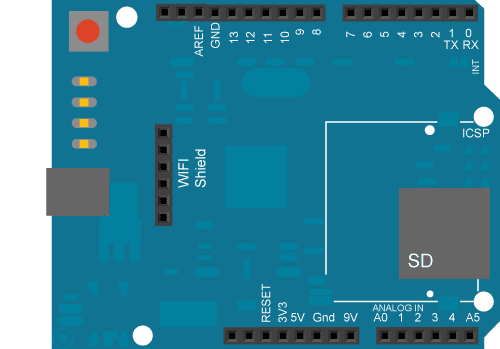WiFi Web Server
Serve a webpage from the WiFi shield with Analog Input values.
In this example, you will use your WiFi Shield and your Arduino board to create a simple Web server. Using the WiFi library, your device will be able to answer a HTTP request with your WiFI shield. After opening a browser and navigating to your WiFi shield's IP address, your board will respond with just enough HTML for a browser to display the input values from all six analog pins.
This example is written for a network using WPA encryption. For WEP or WPA, change the Wifi.begin() call accordingly.
Hardware Required
Arduino WiFi Shield
Shield-compatible Arduino board
(optional) Six analog sensors attached to Analog Pins 0-5
Circuit
The WiFi shield uses pins 10, 11, 12, and 13 for the SPI connection to the HDG104 module. Digital pin 4 is used to control the chip select pin on the SD card.
You should have access to a 802.11b/g wireless network that connects to the internet for this example. You will need to change the network settings in the sketch to correspond to your particular networks SSID.
For networks using WPA/WPA2 Personal encryption, you need the SSID and password. The shield will not connect to networks using WPA2 Enterprise encryption.
WEP network passwords are hexadecimal strings known as keys. A WEP network can have 4 different keys; each key is assigned a "Key Index" value. For WEP encrypted networks, you need the SSID, the key, and key number.
image developed using Fritzing. For more circuit examples, see the Fritzing project page
In the above image, the Arduino board would be stacked below the WiFi shield.
Warning
This example doesn't require an SD card. If an SD card is inserted but not used, it is possible for the sketch to hang, because pin 4 is used as SS (active low) of the SD and when not used it is configured as INPUT by default. Two possible solutions:
remove the SD card;
add these lines of code in the setup()
1pinMode(4, OUTPUT);2digitalWrite(4, HIGH);Code
1/*2
3 WiFi Web Server4
5 A simple web server that shows the value of the analog input pins.6
7 using a WiFi shield.8
9 This example is written for a network using WPA encryption. For10
11 WEP or WPA, change the Wifi.begin() call accordingly.12
13 Circuit:14
15 * WiFi shield attached16
17 * Analog inputs attached to pins A0 through A5 (optional)18
19 created 13 July 201020
21 by dlf (Metodo2 srl)22
23 modified 31 May 201224
25 by Tom Igoe26
27 */28
29#include <SPI.h>30#include <WiFi.h>31
32char ssid[] = "yourNetwork"; // your network SSID (name)33char pass[] = "secretPassword"; // your network password34int keyIndex = 0; // your network key Index number (needed only for WEP)35
36int status = WL_IDLE_STATUS;37
38WiFiServer server(80);39
40void setup() {41
42 //Initialize serial and wait for port to open:43
44 Serial.begin(9600);45
46 while (!Serial) {47
48 ; // wait for serial port to connect. Needed for native USB port only49
50 }51
52 // check for the presence of the shield:53
54 if (WiFi.status() == WL_NO_SHIELD) {55
56 Serial.println("WiFi shield not present");57
58 // don't continue:59
60 while (true);61
62 }63
64 String fv = WiFi.firmwareVersion();65
66 if (fv != "1.1.0") {67
68 Serial.println("Please upgrade the firmware");69
70 }71
72 // attempt to connect to Wifi network:73
74 while (status != WL_CONNECTED) {75
76 Serial.print("Attempting to connect to SSID: ");77
78 Serial.println(ssid);79
80 // Connect to WPA/WPA2 network. Change this line if using open or WEP network:81
82 status = WiFi.begin(ssid, pass);83
84 // wait 10 seconds for connection:85
86 delay(10000);87
88 }89
90 server.begin();91
92 // you're connected now, so print out the status:93
94 printWifiStatus();95}96
97void loop() {98
99 // listen for incoming clients100
101 WiFiClient client = server.available();102
103 if (client) {104
105 Serial.println("new client");106
107 // an http request ends with a blank line108
109 bool currentLineIsBlank = true;110
111 while (client.connected()) {112
113 if (client.available()) {114
115 char c = client.read();116
117 Serial.write(c);118
119 // if you've gotten to the end of the line (received a newline120
121 // character) and the line is blank, the http request has ended,122
123 // so you can send a reply124
125 if (c == '\n' && currentLineIsBlank) {126
127 // send a standard http response header128
129 client.println("HTTP/1.1 200 OK");130
131 client.println("Content-Type: text/html");132
133 client.println("Connection: close"); // the connection will be closed after completion of the response134
135 client.println("Refresh: 5"); // refresh the page automatically every 5 sec136
137 client.println();138
139 client.println("<!DOCTYPE HTML>");140
141 client.println("<html>");142
143 // output the value of each analog input pin144
145 for (int analogChannel = 0; analogChannel < 6; analogChannel++) {146
147 int sensorReading = analogRead(analogChannel);148
149 client.print("analog input ");150
151 client.print(analogChannel);152
153 client.print(" is ");154
155 client.print(sensorReading);156
157 client.println("<br />");158
159 }160
161 client.println("</html>");162
163 break;164
165 }166
167 if (c == '\n') {168
169 // you're starting a new line170
171 currentLineIsBlank = true;172
173 } else if (c != '\r') {174
175 // you've gotten a character on the current line176
177 currentLineIsBlank = false;178
179 }180
181 }182
183 }184
185 // give the web browser time to receive the data186
187 delay(1);188
189 // close the connection:190
191 client.stop();192
193 Serial.println("client disconnected");194
195 }196}197
198void printWifiStatus() {199
200 // print the SSID of the network you're attached to:201
202 Serial.print("SSID: ");203
204 Serial.println(WiFi.SSID());205
206 // print your WiFi shield's IP address:207
208 IPAddress ip = WiFi.localIP();209
210 Serial.print("IP Address: ");211
212 Serial.println(ip);213
214 // print the received signal strength:215
216 long rssi = WiFi.RSSI();217
218 Serial.print("signal strength (RSSI):");219
220 Serial.print(rssi);221
222 Serial.println(" dBm");223}Last revision 2018/08/23 by SM
Suggest changes
The content on docs.arduino.cc is facilitated through a public GitHub repository. If you see anything wrong, you can edit this page here.
License
The Arduino documentation is licensed under the Creative Commons Attribution-Share Alike 4.0 license.
